|
Visit of
Thomas Hardy School (Dorchester, Dorset, UK)25 November 2001
Below it's the report prepared by the students and
tutors. Follow this link for the same report
at Dorset.
T.H.S Field Trip to ING, La
Palma
Thomas Hardye School Visit to the Isaac Newton Group of Telescopes,
European Northern Observatory, La Palma 23rd to 30th November, 2001.
On 23rd November, five students, two staff, and three support staff, from the
Thomas Hardye School,
Dorchester travelled to the island of La Palma, in the Canaries, as the start of
their Field Trip to the Isaac Newton Group of Telescopes in the European
Northern Observatory. The five students were Daniel Heanes, Ben Cowsill, Richard
Mott, Howard Williams, Year 13, and William Hollins, Year 12. The staff from
Thomas Hardye School were Mrs L. Harwood, and Mrs J. Harley. Support astronomers
Mr David Strange and Mr Bob Mizon accompanied the
party, as did Mr Alan Harwood.
|
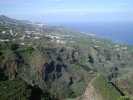
Barranco de La Galga
|
The following day, the 24th November, was spent exploring the local
vicinity. We shopped for food, and visited the local viewpoint at Mirador
de la Galga, where we had good views over the Barranco de La Galga. Lots
of the exotic plants which we struggle to grow indoors at home grow
naturally outdoors on the island. |

Bird of Paradise Plants
|
|
On the morning of 25th November, we travelled up to the Observatory.
Rains had brought rocks down over the mountain roads and at the beginning
of the journey, one of the cars lost the oil from it’s sump We were then
down to three cars, and shortly afterwards a further car suffered a
puncture due to the rocks brought down in rainfall. This was repaired
before the long ascent up the mountain to the observatory. The ascent to
the top of the 7,200 ft mountain took place for the most part through
thick cloud. We were hoping that the observatory was above the cloud, as
it is for all but five nights of the year. We were apprehensive when
arriving at the top of the mountain that our visit had coincided with one
of those five nights! The mountain top was totally covered in cloud; the
temperature was 0 degrees Centigrade, and it was raining! At the lower
atmospheric pressure our crisp bags blew up! |
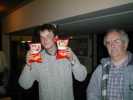
Inflated Crisp Bags
|
|
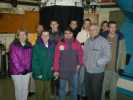
The Group at the JKT
|
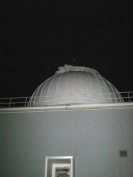
J.K.T. Dome
|
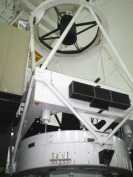
William Herschel Telescope
|
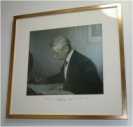
Jacobus Kapteyn
|
|
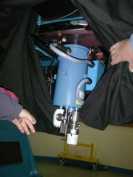
The CCD on the JKD
|
We programmed in the nights viewing before returning to the residence
for the evening meal.We had intended to image M1, the Crab Nebula, but
this had already been imaged as part of the Messier Objects in the JKT set
of Professional Images. We found that the school from La Palma, who had
been observing the previous evening had met with one of the five evenings
a year when viewing is impossible, and had failed to image their objects.
As part of a collaborative programme we agreed to image their programme of
M76, 78, and M103. We programmed in the Right Ascension and Declination
coordinates for all of these objects so that the telescope would image
these in turn. The images were to be taken using Visible, Red and Violet
filters, as well as Infra red, and two types of Hydrogen Alpha filter. For
some of the images this meant an imaging time in excess of one hour. We
watched Javier fill the Cryostat with liquid nitrogen to keep random
electronic noise in the detectors to a minimum. |
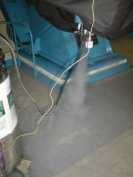
The Cryostat Filling
|
After M76, M78 and M103 (the last Messier object which Messier actually
imaged himself) were imaged we imaged some galaxies from the New General
Catalogue, at the request of a Dutch Astronomer, Johan Knapen, who hopes to
establish a connection between the radii of spiral arms of barred galaxies, and
the radius of the central nucleus.
|
David and Bob set up a small telescope outside the dome during the
night. The sky was brilliantly clear, with the Milky Way very visible.
David pointed out many galaxies and nebula only visible from the U.K. with
much bigger telescopes. Comet Linear was also visible; without the latest
coordinates for this quickly moving comet it was not possible to find it
in the JKT, with it’s narrow arc-second window., but it was visible in the
small telescope. There were many more stars visible than in the polluted
atmosphere at home, and many more because of the different latitude.
During the night Bob noticed the “Zodiacal Light” , which is a column of
light formed by the Sun’s light reflecting from dust in the solar
system. |
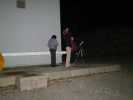
Telescopes being set up outside
JKT
|
We returned to the Residence at 6.00 a.m. I personally slept until
the sun lit up the mountain at 6.30 a.m., and visited the Isaac Newton Telescope
for our E.N.O. shirts and mugs, but some of the team slept until 15.30 hours.
Before leaving the mountain we visited the highest point, Roque de los Muchacos
to view the panorama from the top. We e-mailed colleagues at home to tell them
of our successful night’s viewing. We then returned to sea level for the
evening, and a well-earned sleep.
|

|
|
Panoramic View from Roque de los Muchacos |
|
During the rest of the week we visited the volcanic region of the south
of the island to see the Volcano of Teneguia and the Volcano of San
Antonio. One other day we visited the Caldera de Taburiente, viewing it
from the south , at La Cumbrecita. The Caldera is a vast cauldron formed
by land-slip. We could see the Observatory on the rim of the Caldera. We
had been hopeful of swimming in Chaco Azul, a swimming pool filled by sea
water, but on our visit the sea was violently filling the pool and the red
flag was prohibiting swimming. The lads were disappointed because this was
the only swimming we could permit on the island where the sea currents are
quite strong. When we visited the visitor’s centre in Los Llanos we
noticed a rainbow over the road up to La Cumbrecita It completely filled
the valley. |
|
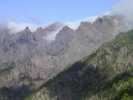
The Volcano at Teneguia
|
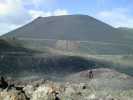
Caldera de Taburiente
|
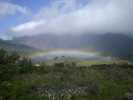
Rainbow over the Valley at Los Llanos
|
|
We returned to the UK on Friday 30th November; again by two different
routes The students returned with Mrs Harley directly to Gatwick. Mr and
Mrs Harwood , Mr Strange and Mr Mizon returned via Tenerife North and
Barcelona. Once home David Strange set about making accounts of the visit
to La Palma visible on his own web page and
those of the Wessex
Astronomical Society and the Thomas Hardye School. David will also
make his photo images available to students. |
We would like to thank Javier Mendez Alvarez for his encouragement and effort
to allow us to complete this observational programme. The students gained much
from the visit, in “work experience”, in astronomy knowledge, and in knowledge
of the geology of the beautiful island of La Palma, and the school would like to
participate in further visits, and also arrange exchanges with La Palmita School
in Santa Cruz.
As there is presently no schools travel organisation running visits to La
Palma, the arrangements for the visit had to be made independently. At times
they were fraught with difficulty, with rescheduled routes etc., in the
aftermath of September 11th. We did make it although we are still seeking
compensation for extra costs after changes in the last week necessitating our
own payment of £40.00 for a taxi between two airports put into the routing
schedule one week before the trip.
Teachers who are interested in carrying out similar visits our sending
students with our school are invited to contact me for further information.
Lin Harwood
The above is a brief account for those who took part in the field trip (our
county science advisor is keen to know about the visit, so has been given
references to the web sites, as have family and friends). We will have more
material available from the European Northern Observatory in weeks to come. Our
images should be of sufficient quality, despite the variable viewing conditions,
to warrant publication in the JKT set of Messier objects, and we will have our
own versions made available of these images. I will be making contact with our
“partner school”, La Palmita.in Santa Cruz de la Palma, to arrange exchange
visits. I will also make available, through web pages, information to students
interested in future visits.
My thanks to those who made this visit possible, particularly Javier Mendez
Alvarez at the Isaac Newton Group of Telescopes, European Northern Observatory,
La Palma.
Lin Harwood, Thomas Hardye School, Dorchester, Dorset, England
Other Pictures
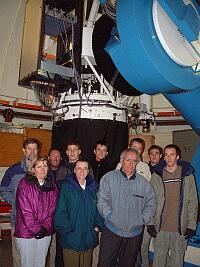 | 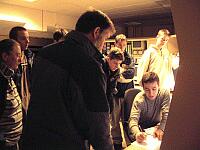 | |
| The group of
observers at the Jacobus Kapteyn Telescope [ JPEG | TIFF ] |
The students meet
the WHT observer while it is cloudy [ JPEG | TIFF ] |
|
|




